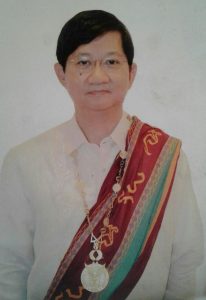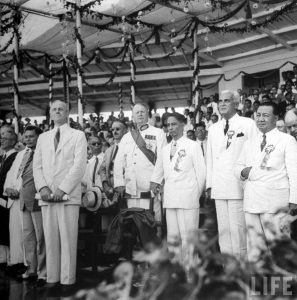Ties That Continue to Bind
Ties That Continue to Bind
The Philippines and the United States under Duterte

By Roland G. Simbulan
(Delivered on June 18, 2021 at the online launch of 1Sambayan, Canada Chapter.)
Year 2021, marks the 500 years since the Spanish empire planted its flag on our islands. Named after Spain’s King Philip II, we became its colony for the next 377 years. The Dutch, and the British too, wanted to oust the Spaniards and incorporate the Philippines into their own empires. Britain almost succeeded, capturing the walled fortress of Intramuros in Manila but only for four years. Then came the United States which offered to help our revolutionary ancestors in freeing us from the Spanish yoke, only to betray the country by making it their own colony, and annexing it to the emerging U.S. empire. During World War 2, the Japanese Imperial Army occupied the country for three years. The Philippines, being endowed with rich natural resources, has been the object of big powers fighting each other for regional supremacy in order to gain from its strategic location in Southeast Asia.
Today, the Philippines is still the “bone of contention” of big powers because of its strategic location dividing the South China Sea and the Pacific. The United States is today waging a new Cold War against China, an emerging world power challenging U.S. hegemony in the Asian region. At stake in the U.S.-China rivalry in the region is the competition for control of the maritime trade routes for vital energy resources and raw materials, fishing grounds, offshore mineral resources, and potential oil and gas resources to fuel capitalist development and growth.

July 4, 1946 granting of nominal independence of the Philippines by the United States at the Luneta Park, Manila.
Photo: Presidential Museum and Library PH
Despite Philippine President Rodrigo Duterte’s seeming pivot and coziness towards China, the country’s alliance with the United States remains rock solid and is even on the upturn. Manila and Beijing may claim a “comprehensive strategic partnership” but it cannot match the ironclad ties that the Philippines has and continues to have, with its former colonial master, the United States.
Duterte’s early histrionics against the U.S. over human rights violations raised by the latter, with threats to cut ties, were mere braggadocio. While China dangles economic aid and increased investments to the Philippines, including China’s “vaccine diplomacy”, America’s footprints in the country are firm and military assistance is up, as are joint war exercises. At least 60 retired military and police generals have been assigned to head key cabinet positions and traditionally civilian agencies. Professionally, they value close Pentagon ties. In the first quarter 2021 survey of Pulse Asia Research, China remains the most highly distrusted country by most Filipinos from among the top six trading partners of the Philippines. Philippine defence officials make sure their president’s pivot from America won’t plod an inch. The U.S. takes Duterte’s courtship dance with China as mere aberration — tolerable for as long as America’s geopolitical interests are not compromised. For, unlike the beleaguered Myanmar coup generals who depend on Xi Jin Ping for survival, the U.S. is still the lifeline of Duterte.
Thus, while joint Philippine-U.S. war exercises scaled down in 2017, the number climbed to 261 in 2018, and 281 in 2019, with the same number set in 2020, if not for the Covid-19 pandemic. The Philippines hosts “Balikatan” (shoulder to shoulder) the largest war exercises with the U.S. in the Southeast Asian region, boosting the “interoperability operations” of both countries in the Western Pacific.
75 years of U.S.-Philippine diplomatic relations since 1946, and 41 years as a colony of the United States has left 4 million U.S. citizens of Filipino-descent living in the U.S. as American citizens, and at least 350,000 U.S. citizens residing in the Philippines. Filipinos are also the largest immigrant Asian group in the U.S. armed forces, which operates globally on every continent on land and sea.
Dominated by the American Chamber of Commerce of the Philippines (ACCP), the Joint Foreign Chambers of Commerce and the local business community have traditionally fully supported harmonious Philippine-U.S. relations. The ACCP has been hostile to threats to alter this status quo. These influential foreign business associations have long been the obstacles to an independent foreign policy.
Probably the most reliable pro-U.S. institution in the country is the military and police organisation. A creation of the United States Army in 1903 to crush Filipino freedom fighters seeking independence, the Philippine military and police forces were established as adjuncts of the U.S. Army. Despite the granting of nominal Philippine independence in 1946, the Philippine military and police continue to be trained, indoctrinated and armed by the United States. The best Filipino military officers are given slots at the U.S. Military Academy at West Point, the U.S. Naval Academy at Annapolis and at other specialised U.S. military training programs. A permanent team of U.S. military advisers in the Philippines, the Joint U.S. Military Advisory Group (JUSMAG), continue to give direction and advise to local security forces. Because of its indoctrination and dependence on U.S. weaponry, the Philippine military has historically and consistently supported U.S. wars of aggression in Korea, Vietnam, Iraq and Afghanistan.
To help modernise the Armed Forces of the Philippines (AFP) as an allied army in the region, Washington continues to provide substantial military assistance, making the Philippines its biggest recipient in Southeast Asia, with increasing amounts of arms and equipment in the past four years of Duterte, broken down as follows: $55.1 million in 2017, $54.4 in 2018, $43.4 million in 2019 and $58.5 million in 2020. The U.S. has continued to deliver war planes, ships, armoured vehicles, small arms and other military equipment. This is supplemented by counter-terrorist training and education, special logistics education and law enforcement assistance in the anti-illegal drug campaign. In fact, the Philippines is still one of the largest recipients of U.S. military aid in Southeast Asia. This military and police equipment and training supported Duterte’s anti-illegal drug war which has claimed almost 30,000 Filipino lives.
Increased militarisation and bombings backed by U.S. drones and U.S. advisers, have caused the displacement of some 450,000 civilians especially in Mindanao, the Philippines’ second largest island. According to Brown University’s Watson Institute for International Relations, the Philippines is one of the 85 countries where U.S. armed forces overseas have active operations, provide training and assistance in counter-terrorism, joint military exercises and construction of U.S. military facilities. This continuing U.S. military presence in the Philippines is crucial for the U.S.-Japan-India-Australia QUAD strategy of encircling and containing China through a NATO-like military alliance in Asia.
With the 2020 Philippine Anti-Terror Law in place, Philippine soldiers and their paramilitaries are committing atrocities against unarmed indigenous communities who oppose the encroachments of logging and mining conglomerates, as well as the assassination of labor and peasant leaders, critics and lawyers who have been publicly red-tagged as “terrorists” in social media before being killed.
The U.S. remains to be the number one source of weapons to the Philippines. U.S. military assistance however, does not effectively serve to defend the Philippines against the Chinese intrusions and island-reclamations in the West Philippine Sea, under Philippine jurisdiction. Rather, the foreign military assistance is being turned against the vulnerable and marginalised, the journalists, labor union leaders, lawyers, priests, human rights defenders, indigenous peoples and other peaceful dissenters. The “shoot to kill” approach – highly aggressive military-police operations – in both the anti-illegal drug and anti-insurgency campaigns, have been the pattern under Duterte. In the case of the anti-terror, anti-insurgency campaign, it is the unarmed civil society activists who are in fact being demonised and attacked as “terrorists” and then targeted for assassination by death squads – directed and armed by state security forces. But this is hardly news. The purely military means is used to address the country’s socio-economic problems, dissent and insurgency. Thus, U.S. military assistance has only armed the militaristic approach against critics and dissenters in the Philippines.
With the absence of large permanent military bases which were closed down in 1992, the U.S. continues to maintain its military hegemony in the Philippines through controversial treaties and agreements like the 1951 Mutual Defence Treaty (MDT), the 1999 Visiting Forces Agreement (VFA), and the 2014 Enhanced Defence Cooperation Agreement (EDCA). The Philippines has long been considered a crucial location in U.S. long-term security in Asia. U.S. forces need the Philippines for refuelling and logistics support for their operations in the Arabian Gulf or Western Pacific. With Fortress America still securely in place in the Philippines, the U.S. would be able to launch air and sea actions in the contested South China Sea, and to continue to launch military operations in the Asia-Pacific and the Middle East.
However, people’s movements in the Philippines and in the region are challenging this militarised geopolitics which is still dominated by the United States with a framework of “people’s security.” Furthermore, transnational civil society organisations in the region have emerged and have become a powerful voice, focusing on social and economic justice and respect for people’s civil and political rights as the foundation of genuine and sustainable peace.
———————————–
Roland G. Simbulan is a Professor at the University of the Philippines and is author of eight books on Philippine-U.S. relations and Philippine foreign policy. He is Vice Chair of the Center for People’s Empowerment in Governance (CenPeg) Email: rgsimbulan@up.edu.ph
Comments (0)